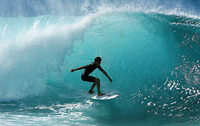 Yesterday, one of my former students met with me to discuss recording audio for a video about surfing that he and his colleagues were planning. Recording production sound out on the ocean is not a simple task. It is even more difficult when you do not have much of a budget.
Yesterday, one of my former students met with me to discuss recording audio for a video about surfing that he and his colleagues were planning. Recording production sound out on the ocean is not a simple task. It is even more difficult when you do not have much of a budget.
If this were a Hollywood feature, here is how we would approach it.
Sound effects of the actual surfing sequences would be faked back at the studio. When you are actually on the board, enveloped by a monstrous wave, the natural sound is thunderous. The only thing you would be able to hear or record would be the roar of the ocean. Forget any dialogue or subtle sound effects.
So we would aim some mics towards the surf, and record what we could. Back at the studio, we would Foley the subtle sound effects, such as paddling into place, or even the squeak of feet as the surfer repositions on the board (which, by the way, you would never have heard in real life, but it makes good cinema).
If there were a few lines of dialogue, grunts, or curses -- these would be wild lined or ADR'd and simply cut in, over the shots of the surfer.
Although it is possible to deploy bona fide waterproof wireless mics in the water, bear in mind that these are expensive to rent and have to specially ordered (or purchased) well in advance. Even if you had such equipment, the audio would still suffer from a lot of "clothing" noise (rubbing of the wet suit, and water splashes directly onto the lavalier), not to mention the overwhelming roar of the background.
For the quieter scenes, such as paddling out, or calmly adrift in the ocean -- there are two approaches. One would be for camera and sound to be in a zodiac rubber boat. A very directional (long) shotgun mic could be boomed out, pretty much directly overhead of talent on their board. The ideal mic would be either the (discountinued) Audio Technica AT895 spaced array DSP microphone system, or the new Schoeps SuperCMIT system.These mics use very sophisticated phase array technology and DSP processing to hold back tons of side noise.
Otherwise, use the most directional standard condenser long shotgun available to you, such as the Audio Technica BP4071 or BP4071-L, or Sennheiser MKH70.
Make sure that you use extra wind protection along with a full zeppelin system. It is very windy out there! I would recommend slipping a thin foam windscreen over the mic itself, inside of the zeppelin shell. Make sure to leave an airspace between the foam and the shell. A standard foam windscreen might prove to be too thick, so you may have to search around or make your own out of acoustic speaker foam wrapped around the body of the mic.
You will also need a good furry cover over the outside of the shell. Make sure to douse the fake fur with water repellent, and brush out all of the clumps. Do a soundcheck with a thin (dry) condom in place over the mic, but inside of the foam windscreen. If it does not cut out too many frequencies, then use it as extra resistance against surf spray. But understand, that it might not protect the mic from being dipped completely underwater!
Keep in mind that there is no insurance company that will readily underwrite any audio equipment used in such a high risk environment as a surf board or zodiac camera boat, so the producer will have to put up a hefty cash security deposit. Even if the Producer claims that they have production insurance, I would verify it personally, directly with the INSURANCE COMPANY, and get it in writing that these risks are covered. Many times, the insurance agent (eager to make a sale) will assume that you are only shooting from the beach, and neglects to point out the very fine print on page 47 that indicates all of the high risk situations are NOT covered.
The other approach would be to fake it in close-up, away from the ocean. Put the surfboard just a short distance offshore in a calm lagoon or lake. Shoot and boom from the shore, dock, or pier. As long as you frame it properly, the audience should not know that it was a cheat.
The student then told me that they had no budget for a zodiac, and planned to shoot everything from an HDSLR in an underwater housing, from a surfboard! Large, bulky, expensive. No way to get audio connections in.
Why HDSLR ? For the BETTER picture quality, of course! Forget the fact that the camera will be a shakey-cam.
Just what the world needs when it gest bored from watching cat videos on YouTube. More shakey surfing footage, captured one handed from a precariously balanced board in the ocean. At least use some miniature and inexpensive waterproof GoPro HD cams, and get some decent footage.
If you are going to go to all the trouble to make a film, then make a good one that you can be proud of. Don't just be one more work-of-crap on the internet; stand out and be better than the rest.
If you can't do that, then save your money and energy for a better project.